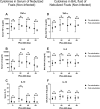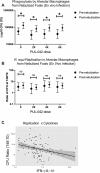Host-directed therapy in foals can enhance functional innate immunity and reduce severity of Rhodococcus equi pneumonia
- PMID: 33510265
- PMCID: PMC7844249
- DOI: 10.1038/s41598-021-82049-y
Host-directed therapy in foals can enhance functional innate immunity and reduce severity of Rhodococcus equi pneumonia
Abstract
Pneumonia caused by the intracellular bacterium Rhodococcus equi is an important cause of disease and death in immunocompromised hosts, especially foals. Antibiotics are the standard of care for treating R. equi pneumonia in foals, and adjunctive therapies are needed. We tested whether nebulization with TLR agonists (PUL-042) in foals would improve innate immunity and reduce the severity and duration of pneumonia following R. equi infection. Neonatal foals (n = 48) were nebulized with either PUL-042 or vehicle, and their lung cells infected ex vivo. PUL-042 increased inflammatory cytokines in BAL fluid and alveolar macrophages after ex vivo infection with R. equi. Then, the in vivo effects of PUL-042 on clinical signs of pneumonia were examined in 22 additional foals after intrabronchial challenge with R. equi. Foals infected and nebulized with PUL-042 or vehicle alone had a shorter duration of clinical signs of pneumonia and smaller pulmonary lesions when compared to non-nebulized foals. Our results demonstrate that host-directed therapy can enhance neonatal immune responses against respiratory pathogens and reduce the duration and severity of R. equi pneumonia.
Conflict of interest statement
Dr. Hook has received compensation as a member of the scientific advisory board of Pulmotect, Inc. and owns stock options in the company. Drs. Scott and Johnson are employees of Pulmotect, Inc. and own stock options in the company. The other authors declare no competing interests.
Figures






References
-
- Horowitz ML, et al. Application of Sartwell's model (lognormal distribution of incubation periods) to age at onset and age at death of foals with Rhodococcus equi pneumonia as evidence of perinatal infection. J. Vet. Intern. Med. 2001;15(3):171–175. - PubMed
Publication types
MeSH terms
Substances
LinkOut - more resources
Full Text Sources
Other Literature Sources

